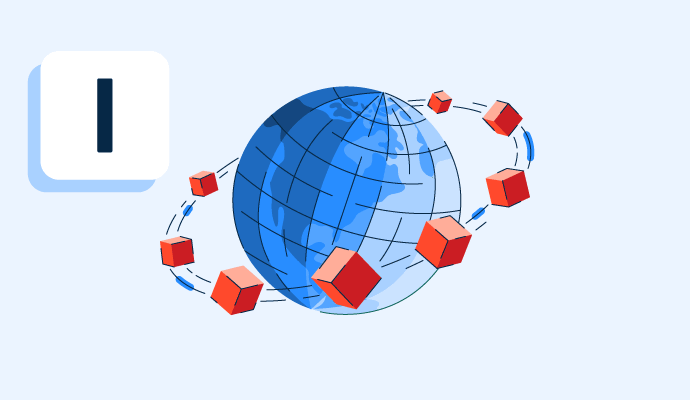What is internet protocol?
Internet protocol connects devices and facilitates data transmission across global networks. It’s a set of rules and conventions that manages data packets’ formatting, addressing, transmitting, routing, and receiving.
It’s the method by which data is sent from one computer to another. Sending data through email or a webpage happens through data packets. These are the meat of the original message. They hold both the sender's and receivers’ internet addresses.
The packet first goes to a gateway computer. It sits between different networks and applications. It reads the destination’s address and forwards the packet to the next gateway computer until the target computer is in its nearest neighborhood.
The gateway computer directly sends the packet when it finds the target computer. Since the message is divided into several packets, each packet may take a different route to reach the target computer.
Not all messages come from genuine sources. Often, malicious hackers send malware or other criminal content. Businesses and professionals use domain name system (DNS) security software to protect DNS servers against incidents.
What is an IP address?
An IP address is a unique address designated to each domain or device that connects to the internet. Each one is a numerical series generated by translating human-readable domain addresses into numbers via DNS resolvers. IP addresses serve two primary functions:
- Device identification: IP addresses identify devices such as computers, smartphones, tablets, and servers on a network or the internet. Identification is essential for establishing secure connections and communicating easily between domains.
- Routing: Data is divided into IP packets for network transmission; each packet contains the IP addresses of the source and destination devices. It’s meant to figure out the best route for these data packets.
Understanding IP packets and IP routing
IP packets carry data and an IP header. On a transmission control protocol/IP (TCP/IP) network, TCP packets are divided into bits and packaged into data packets for transmission. The original data comes back together once the packets arrive at their destination.
IP routing and addressing are two of the IP’s primary roles. Routing is the process of using IP addresses to forward IP packets from source to destination devices over a network. Usually, a router is used for this transmission. The router employs the destination IP address to find the right stop across a network of routers.
Internet protocol security
Internet protocol security (IPSec) is a system of open standards for guaranteeing private, secure communications over IP networks. It uses cryptographic services to guarantee security. Organizations deploy IPSec for existing networks because it doesn't call for any modifications to programs or protocols.
IPSec offers the following security services:
- Authenticated data sources for determining who sent it.
- Encryption and confidentiality to guard against no data breaches during transmission.
- Integrity without a connection to make sure there’s no data modification in transit.
- Replay protection helps defend against denial of service (DoS) attacks by identifying packets received more than once.
Types of internet protocol
Several other network protocols run in parallel with IP to add in communication and data transfer across the World Wide Web.
- IPv4/IPv6: IPv4, or Internet Protocol version 4, is the most popular IP version. There are 232 addresses possible, thanks to the 32-bit address format used. As IPv4 addresses ran out, IPv6, aka Internet Protocol version 6, was developed. Its 128-bit address system makes an almost infinite number of distinct addresses available.
- Transmission control protocol (TCP) is a connection-oriented protocol that guarantees trustworthy and systematic data transport between devices. Data is divided into packets, given a number, and then reassembled at the destination.
- User datagram protocol (UDP) is a connectionless protocol that’s quicker than TCP, but doesn’t ensure packet delivery. Typical real-time applications include internet video streaming and online gaming.
- Hypertext transfer protocol (HTTP) is the basis for all data transfers over the internet. It makes the transmission of hypertext easier. HTTPS is a secure variant that adds an extra layer of encryption using protocols like secure sockets layer (SSL) or transport layer security (TLS).
- File transfer protocol (FTP) is a protocol for exchanging files between computers connected to a network. It offers a method for quickly uploading and downloading files.
- Instant messaging access protocol/ Post office protocol (IMAP/ POP3) lets many devices view and manage emails while downloading emails from a server to a single device.
- Border gateway protocol (BGP) is a routing protocol essential to how the internet works. It controls how autonomous systems share routing data.
- Dynamic host configuration protocol (DHCP) automatically provides IP addresses to networked devices, making network configuration more straightforward.
- Domain name system (DNS) converts human-readable domain names into IP addresses. It lets users visit websites using words rather than IP numbers.
IPv4 vs. IPv6
The older and more popular protocol is IPv4. However, IPv4 addresses are running out because many devices are connected to the network. Unlike IPv4, IPv6 uses a 128-bit address system, offering a considerably increased number of potential addresses. As more and more devices become online, this version is vital to the internet's continued expansion. IPv6 provides improved network setup and better security when compared to IPv4.
Despite IPv6's advantages, the infrastructure built around IPv4 has made the switch from IPv4 sluggish. Although many networks and devices still use IPv4, developers promote IPv6 adoption to protect the internet's continued growth and stability.
TCP/IP vs. UDP/IP
The internet highway traffic controller (HTTC) results from combining IP and transmission control protocol. TCP and IP cooperate to transmit data over the internet, albeit at different levels. TCP makes the connection dependable because IP doesn’t ensure reliable data packet delivery over a network.
TCP specifically ensures:
- There is no data packet loss.
- The order of the data packets is correct.
- The delay is within reasonable bounds.
- There aren't any duplicate packets.
Another popular transport protocol is the user datagram protocol (UDP). Although it’s quicker than TCP, it’s less dependable. UDP doesn’t verify every data packet is delivered and in the correct order, and it doesn’t create a connection before sending or receiving data.
Learn more about data transmission and discover how to ensure a smooth data flow.

Sagar Joshi
Sagar Joshi is a former content marketing specialist at G2 in India. He is an engineer with a keen interest in data analytics and cybersecurity. He writes about topics related to them. You can find him reading books, learning a new language, or playing pool in his free time.

